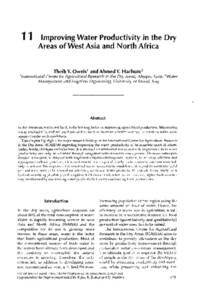Improving Water Productivity in the Dry Areas of West Asia and North Africa

Authors:
In the dry areas, water, not land, is the limiting factor in improving agricultural production. Maximizing water productivity, and not yield per unit of land, is therefore a better strategy for on-farm water man- agement under such conditions. This chapter highlights the major research findings at the International Center for Agricultural Research in the Dry Areas (ICARDA) regarding improving the water productivity of its mandate crops of wheat, barley, lentils, chickpea and faba bean. It is shown that substantial and sustainable improvements in water productivity can only be achieved through integrated farm-resources management. On-farm water-pro- ductive techniques, if coupled with improved irrigation-management options, better crop selection and appropriate cultural practices, improved genetic make-up and timely socio-economic interventions, will help to achieve this objective. Conventional water-management guidelines, designed to maximize yield per unit area, need to be revised for achieving maximum water productivity instead. A case study from Syria shows the applicability of this option. It illustrates that, when water is scarce, higher farm incomes may be obtained by maximizing water productivity than by maximizing land productivity.
